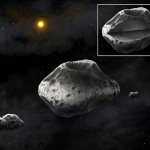W. M. Keck Observatory press release…
Combining observations from the world’s largest telescopes with small telescopes used by amateur astronomers, a team of scientists discovered that the large main-belt asteroid (87) Sylvia has a complex interior, thanks to the presence of two moons orbiting the main asteroid, and probably linked to the way the multiple system was formed. The findings are being revealed today, October 7, at the 45th annual Division of Planetary Sciences meeting in Denver, Colorado.

The team, led by Franck Marchis, senior research scientist at the Carl Sagan Center of the SETI Institute, has continued to observe this triple asteroid system by gathering 66 adaptive optics observations from 8-10m class telescopes including those at the W. M. Keck Observatory, the European Southern Observatory, and Gemini North.
“Because (87) Sylvia is a large, bright asteroid located in the main belt, it is a great target for the first generation of adaptive optics systems available on these large telescopes. We have combined data from our team with archival data to get a good understanding of the orbits of these moons,” Marchis said.
With expert assistance from colleagues at the Institut de Mécanique Céleste et de Calcul des Éphémérides(IMCCE) of the Observatoire de Paris, the team developed an accurate dynamical model of the system, allowing them to predict the position of the moons around the asteroid at any time.
The “drop test” of this work was the prediction of the relative positions of the moons during an occultation on Jan. 6, 2013. Observers equipped with small telescopes located on a narrow path across the south of France, Italy and Greece could see the triple system (87) Sylvia passing in front of a bright 11-mag star. Observers at different locations see different parts of the asteroid, or its moons, passing in front of the star. Such occultations allow exquisitely precise measurements of the relative positions and sizes of the occulting objects.
In collaboration with EURASTER, a group of amateur and professional astronomers, the team successfully motivated ~50 observers to watch the event. Twelve of them detected the occultation by the primary of the system which lasted between 4 and 10 seconds depending on the observer’s position on Earth.
“Additionally, four observers detected a two-second eclipse of the star caused by Romulus, the outermost moon, at a relative position close to our prediction. This result confirmed the accuracy of our model and provided a rare opportunity to directly measure the size and shape of the moon”, Jérôme Berthier, astronomer at IMCCE said.
The chords of this occultation observations revealed that Romulus is 24 km in diameter with an extremely elongated shape, possibly made of two lobes joined together like a dumbbell. This is not surprising if the moon formed from the accretion of fragments created by the disruption of a proto-Sylvia by an impact, several billion years ago.
The team derived the shape of the 270-km primary asteroid Sylvia by combining data from the occultation of the asteroid with other sources of information. These included archived recordings of the variation of light caused by the spin of the asteroid, and direct imaging by adaptive optics systems. Because the moons’ orbits do not seem to be affected by the irregular shape of the asteroid, the team concluded that the large asteroid is most likely differentiated. The asteroid likely has a spherical core of dense material, surrounded by a fluffy or fractured outer surface layer.
“Combined observations from small and large telescopes provide a unique opportunity to understand the nature of this complex and enigmatic triple asteroid system,” Marchis said. “Thanks to the presence of these moons, we can constrain the density and interior of an asteroid, without the need for a spacecraft’s visit. Knowledge of the internal structure of asteroids is key to understanding how the planets of our solar system formed”.

